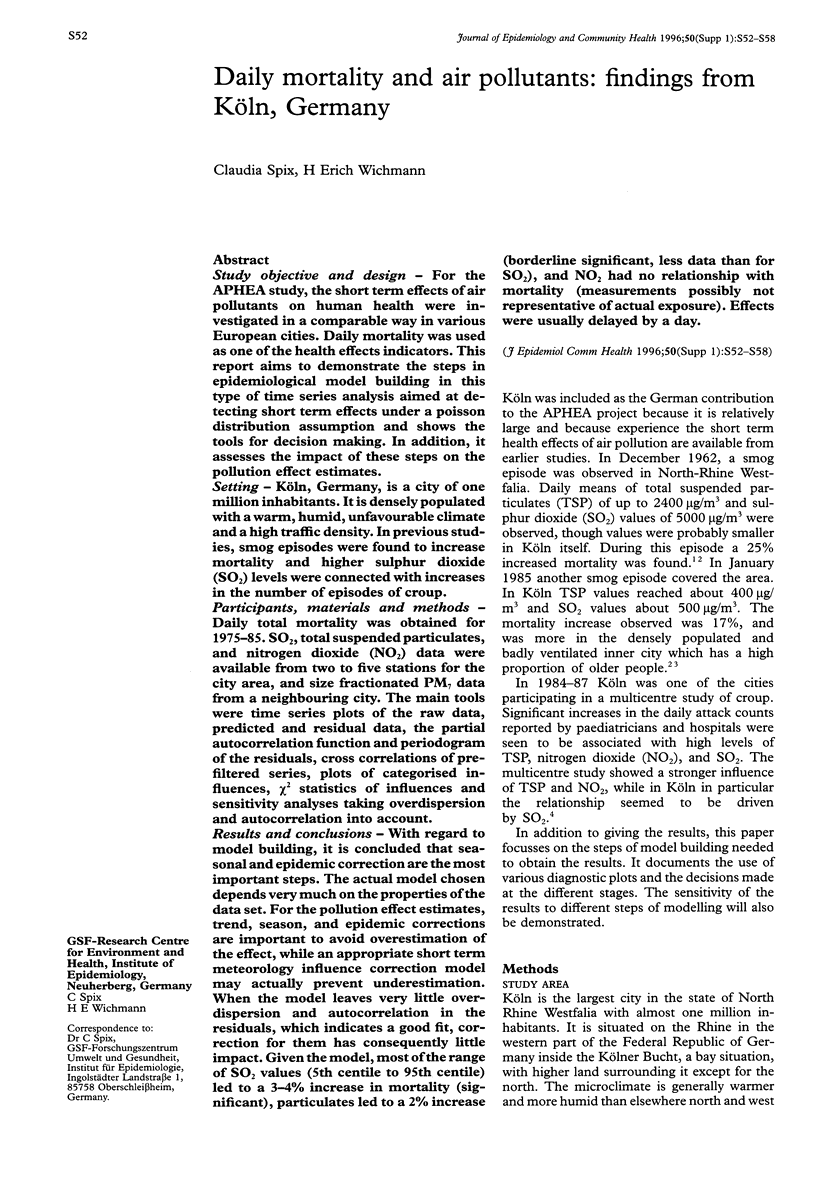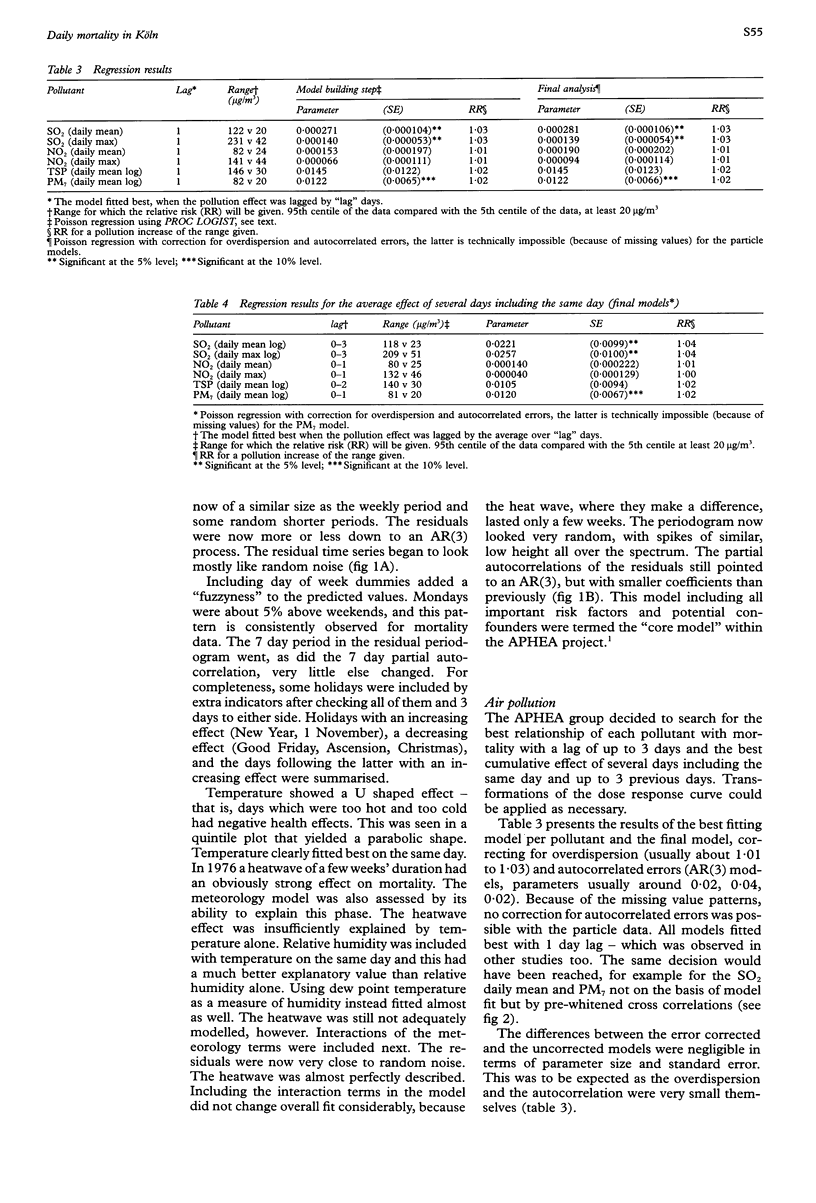Abstract
STUDY OBJECTIVE AND DESIGN: For the APHEA study, the short term effects of air pollutants on human health were investigated in a comparable way in various European cities. Daily mortality was used as one of the health effects indicators. This report aims to demonstrate the steps in epidemiological model building in this type of time series analysis aimed at detecting short term effects under a poisson distribution assumption and shows the tools for decision making. In addition, it assesses the impact of these steps on the pollution effect estimates. SETTING: Köln, Germany, is a city of one million inhabitants. It is densely populated with a warm, humid, unfavourable climate and a high traffic density. In previous studies, smog episodes were found to increase mortality and higher sulphur dioxide (SO2) levels were connected with increases in the number of episodes of croup. PARTICIPANTS, MATERIALS AND METHODS: Daily total mortality was obtained for 1975-85. SO2, total suspended particulates, and nitrogen dioxide (NO2) data were available from two to five stations for the city area, and size fractionated PM7 data from a neighbouring city. The main tools were time series plots of the raw data, predicted and residual data, the partial autocorrelation function and periodogram of the residuals, cross correlations of prefiltered series, plots of categorised influences, chi 2 statistics of influences and sensitivity analyses taking overdispersion and autocorrelation into account. RESULTS AND CONCLUSIONS: With regard to model building, it is concluded that seasonal and epidemic correction are the most important steps. The actual model chosen depends very much on the properties of the data set. For the pollution effect estimates, trend, season, and epidemic corrections are important to avoid overestimation of the effect, while an appropriate short term meterology influence correction model may actually prevent underestimation. When the model leaves very little over-dispersion and autocorrelation in the residuals, which indicates a good fit, correction for them has consequently little impact. Given the model, most of the range of SO2 values (5th centile to 95th centile) led to a 3-4% increase in mortality (significant), particulates led to a 2% increase (borderline significant, less data than for SO2), and NO2 had no relationship with mortality (measurements possibly not representative of actual exposure). Effects were usually delayed by a day.
Full text
PDF






Selected References
These references are in PubMed. This may not be the complete list of references from this article.
- Höpken W., Willers H. Epidemiologie der Influenza seit 1968. Internist (Berl) 1985 Feb;26(2):83–88. [PubMed] [Google Scholar]
- Katsouyanni K., Zmirou D., Spix C., Sunyer J., Schouten J. P., Pönkä A., Anderson H. R., Le Moullec Y., Wojtyniak B., Vigotti M. A. Short-term effects of air pollution on health: a European approach using epidemiological time-series data. The APHEA project: background, objectives, design. Eur Respir J. 1995 Jun;8(6):1030–1038. [PubMed] [Google Scholar]
- Schwartz J. Air pollution and daily mortality: a review and meta analysis. Environ Res. 1994 Jan;64(1):36–52. doi: 10.1006/enrs.1994.1005. [DOI] [PubMed] [Google Scholar]
- Schwartz J., Spix C., Touloumi G., Bachárová L., Barumamdzadeh T., le Tertre A., Piekarksi T., Ponce de Leon A., Pönkä A., Rossi G. Methodological issues in studies of air pollution and daily counts of deaths or hospital admissions. J Epidemiol Community Health. 1996 Apr;50 (Suppl 1):S3–11. doi: 10.1136/jech.50.suppl_1.s3. [DOI] [PMC free article] [PubMed] [Google Scholar]
- Schwartz J., Spix C., Wichmann H. E., Malin E. Air pollution and acute respiratory illness in five German communities. Environ Res. 1991 Oct;56(1):1–14. doi: 10.1016/s0013-9351(05)80104-5. [DOI] [PubMed] [Google Scholar]
- Stronks K., van Trirum H., Mackenbach J. P. A documentation centre on socioeconomic inequalities in health. J Epidemiol Community Health. 1996 Feb;50(1):5–5. doi: 10.1136/jech.50.1.5. [DOI] [PMC free article] [PubMed] [Google Scholar]
- Wichmann H. E., Brockhaus A., Schlipköter H. W. Smogepisoden in Nordrhein-Westfalen und ihre gesundheitlichen Auswirkungen. Offentl Gesundheitswes. 1988 Jun;50(6):314–318. [PubMed] [Google Scholar]
- Wichmann H. E., Mueller W., Allhoff P., Beckmann M., Bocter N., Csicsaky M. J., Jung M., Molik B., Schoeneberg G. Health effects during a smog episode in West Germany in 1985. Environ Health Perspect. 1989 Feb;79:89–99. doi: 10.1289/ehp.897989. [DOI] [PMC free article] [PubMed] [Google Scholar]


